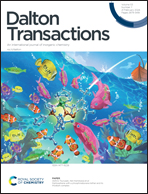Three water-soluble copper(ii) N-heterocyclic carbene complexes: toward copper-catalyzed ketone reduction under sustainable conditions†
Abstract
A series of tridentate copper(II) N-heterocyclic carbene (NHC) complexes with imidazole, benzimidazole, and 5,6-dimethylbenzimidazole azole rings were synthesized and comprehensively characterized via X-ray crystallography, ESI-MS, cyclic voltammetry, and UV-Vis and EPR spectroscopic studies. These complexes were then utilized for the optimization of ketone reduction under sustainable conditions using 2-acetylpyridine and phenylsilane. The relationships between product formation, temperature, reaction time, and catalyst loading for the hydrogenation reactions are covered in detail. Reduction of eighteen different aliphatic, cyclic, and aromatic ketones were demonstrated, which were compatible to produce the corresponding products in moderate to good yields. These systems were used to develop related DNA-hybrid catalytic systems, but only supported weak enantioselectivity. Further thermodynamic experiments showed Cu-NHC complexes did not demonstrate specific binding to DNA, which is consistent with their limited selectivity.



 Please wait while we load your content...
Please wait while we load your content...